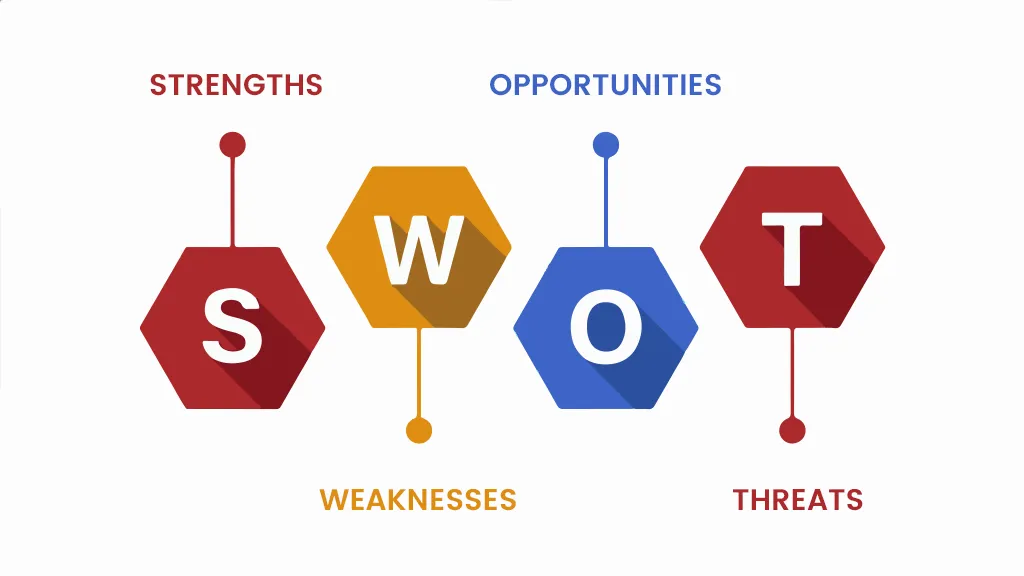Managing a business is hard, and the task becomes more tedious if yours is a gym. There is no one-size-fits-all strategy, as every business is unique in its own way based on services, customers, and pricing plans. Gym owners must wear many hats to manage multiple tasks, from lead generation to client engagement and staff management to budget analysis.
The possibilities of improvements start to narrow down while the chances of errors increase as you juggle multiple tasks. This is where SWOT analysis comes into play and reduces the burden from your shoulders.
What is SWOT analysis?
The term SWOT is used to differentiate four terms. What are those terms? How can you understand the difference between those terms? How can these terms help you improve your gym business? All the answers are listed in the table below.
Suppose you are a gym owner who runs a gym center and faces many issues. For instance, you may lack potential clients because you lack proper gym equipment and didn’t categorize your gym according to different gym sessions. As a matter of fact, your neighbor gyms are getting more members than yours. Have a look into the problems and sort out a way to make a chance.
But, before sorting out a real problem, you have to find out the problem first. Therefore, there might be some things that you are not providing or that you haven’t categorized according to your customers’ attention. Hence, we are here to help by creating a SWOT analysis table that enables gym owners to identify problems and implement solutions. You can find out the strengths, weaknesses, opportunities, and threats. Take a look at it.
| Strengths | Weakness | Opportunities | Threats |
| Top-Notch equipment | Limited budget for marketing | Increasing trend in health and fitness awareness | Competition from new or established gyms |
| Wide range of fitness classes | Uncertified trainers | Corporate wellness program partnerships | The emerging popularity of home workout regimes |
| Convenient and accessible location | Small facility space with limited service offerings | Community events promoting health & wellness | Economic downturns affecting disposable income |
| Experienced and qualified staff | Insufficient parking facilities | Technological advancements in fitness equipment | Changes in health and safety regulations |
| Strong brand recognition | High staff turnover rates | Expansion into online training and virtual classes | Rising costs of gym equipment and maintenance |
| Membership loyalty programs | Inconsistent customer service quality | Collaborations with healthy intake stores | Shifts in Consumer Fitness Preferences |
| Brawny online presence & digital marketing | Limited range of equipment or classes | Growing interest in specific fitness niches | Legal challenges or litigation risks |
| Personalized training and nutrition plans | Dependence on a specific client’s demographics | Emerging local residential or commercial developments | Seasonal fluctuations in gym attendance |
| Clean, well-maintained facilities | Outdated equipment or facilities | Local government initiatives promoting fitness | Increasing rental costs for gym premises |
| Child care services for members | Limited opening hours | Interest in sustainable and eco-friendly fitness solutions | Technological disruptions in the fitness industry |
Notifying this table, you can learn the factors and how to improve your gym business. The only thing that matters for people is a healthy physical and mental lifestyle. As Jim Rohn says,
“Take care of your body. It’s the only place you have to live.”
It’s important for gym owners to ensure their facilities attract more members to grow the business.
It is imperative to understand the basic concepts

Carrying out the SWOT analysis for a gym that you plan to launch can be seemingly complicated, especially when it comes to predicting future clarity, clamor, advantages, and risks.
First, approach a market analysis and review available fitness industry reports. These resources are highly beneficial as they help in understanding the latest shape-up trends, the consumer’s ever-changing preferences, and the competitors one has to face.
Remember that engaging with other gym owners or fitness industry professionals can be highly beneficial. They can provide valuable insights and hands-on lessons that complement the information conveyed through reports alone.
The goal of SWOT analysis is obviously to achieve complete confidence in identifying strengths and weaknesses. Along with seizing opportunities and managing every possible risk, this will empower your decision-making process.
Strengths
Think about what exclusive extra points you are offering in your gym facility. It might be that your gym hosts the latest workout gadgets or that you have a great location in a high-flow traffic environment. Your strength may also be that you have properly qualified and charming trainers who are there to assist members at every step. It may also include workshops that you exclusively host and are not offered anywhere else.
These are inner factors that may improve your gym to be ahead in the market.
Weaknesses
Pinpointing weaknesses is a crucial step towards fostering genuine self-awareness. It provides an opportunity for growth and improvement. Perhaps you’ve identified financial imbalances that hinder your ability to invest in expensive machinery or purchase prominent advertising space. Maybe you’re uncertain about the intricacies of running a gym business or navigating a market saturated with competing interests.
However, recognizing these weaknesses is not a setback but rather a chance to strategize and overcome obstacles. It’s an invitation to seek innovative solutions and leverage resources effectively. By addressing these areas of improvement head-on, you pave the way for personal and professional development, ultimately positioning yourself for more tremendous success in the dynamic landscape of the fitness industry.
In that sense, your gym could be dedicated to just one fitness area, which would certainly affect patronage and prospects. These are areas where you often need to look with more care and attention, or it is always better to get more input and knowledge.
Opportunities
Opportunities in SWOT analysis state favorable advantages involving social and economic factors that your gym could benefit from. These could include partnering with neighborhood enterprises, offering wellness classes, and broadening clientele. If your surroundings do not have the best-equipped gyms, this could also be the gap you can utilize.
Additionally, consider the impact of local events and demographic shifts on your business strategy. Community events, such as festivals or charity fundraisers, present excellent opportunities to attract more foot traffic to your gym. Similarly, the development of new housing complexes or residential areas in your vicinity can indicate potential growth in your customer base.
By staying coordinated with these trends and actively participating in community engagement, you can capitalize on these opportunities to expand your reach and enhance your gym’s visibility within the area.
Threats
Threats are elements that come from the outside and can challenge your gym. Such challenges could range from establishing new health regulations that affect the gym business. People are experiencing an economic slowdown and, hence, are spending less on fitness. It may also include transitions in fitness customers’ tastes, such as the increase in home workout plans, which could also impact a traditional gym business model.
How do you make your gym business better?
Integrating gym management software into your operations can serve as a strategic move identified through SWOT analysis. By implementing such software, you optimize your efforts, streamline fitness routines, and efficiently manage scheduling, organization, and resource allocation. This proactive approach enables you to capitalize on opportunities for improvement.
Retaining customers not only ensures a stable revenue stream but also enables long-term relationships. Gathering valuable feedback on various aspects of your business, including product offerings, customer service, and pricing strategies. This aligns with your strategic goal of leveraging strengths to capitalize on opportunities and mitigate weaknesses.
Furthermore, understanding the dollar value of customer loyalty underscores the importance of strategic decision-making highlighted in your SWOT analysis.
By incorporating these insights into your business strategy, informed by SWOT analysis, you position your gym for sustainable growth and success in the competitive fitness industry.
Conclusion
The success of the gym business can be achieved by thoughtful planning, regular evaluation, and adaptation to the fitness industry’s continuously changing journey. Human involvement incorporates a component of inconsistency. Because of errors, doubts and disbelief may arise even after intensive management and supervision.
Thus, SWOT analysis means using modern tools that allow a review of contemporary gym management software’s strengths, weaknesses, opportunities, and threats. Through a detailed SWOT analysis, gym owners will receive priceless information about their business.
Assets like the highest-quality equipment and the professional staff can be used as a unique selling proposition. It helps to increase the customer base and build new loyal customers.
Through constant improvements and embracing new ideas, gym owners are able to develop a fitness center that satisfies their customers’ needs and succeeds in overstepping them.
